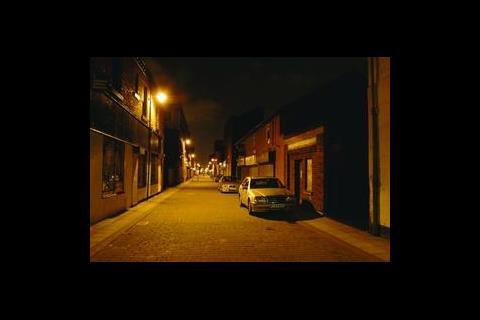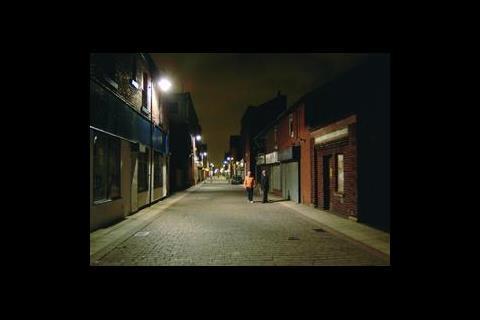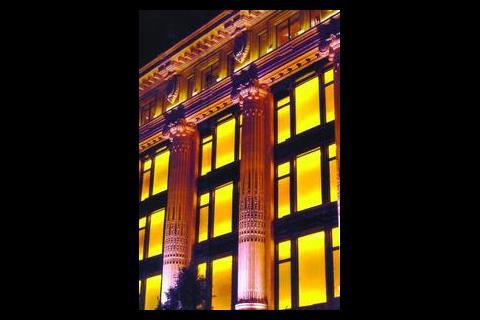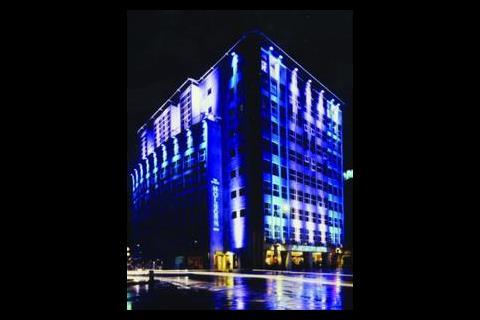With the growth in lighting of amenity areas, there has also been an increase in the use of buried uplights and there are some concerns about the surface temperatures that can be generated in some of these fittings. From a health and safety perspective, and from a professional liability perspective, this is an issue that designers need to consider.
One of the current areas of concern relating to exterior lighting of buildings is the increasing use of colour to wash the facades of buildings. "In these situations, if the lighting is done with thought and feeling for the building, and the space in which the building sits, the results can be very attractive," says Dave Coatham of the Institution of Lighting Engineers. "However, if it is done simply to make the building look different to the one next door – or to make it stand out from others, then the results can be very unattractive," he adds.
As the exteriors of more buildings are lit, rather than being allowed to fade into the obscurity of the night, problems also arise in relation to the lack of co-ordination between different buildings, especially when lighting schemes are done at different times. "The planning legislation is very weak in this respect," says Coatham. "You need permission with regards to where you site the fittings but there is no control of the effect on the building when you light it. Some local authorities are now trying to do something about this. In Trafalgar Square, for example, there is now an attempt to co-ordinate the floodlighting of all of the buildings around the square to make it more coherent," he continued.
Inevitably, the more buildings you light, the more energy you consume. "There is a sustainability angle relating to exterior lighting and an apparent conflict between the social, economic and environmental factors," comments Anthony Wilson of FaberMaunsell. "Exterior lighting certainly has social benefits when it helps with security, and security is one of the key drivers for a sustainable life, but it also has environmental impact. The lighting needs to be direct without spillage, if you're lighting the facade then just light the facade and nothing else. And in some cases a compromise may be required where you do not necessarily use the light sources that give the best colour rendering in order to achieve higher efficiencies," he adds.
The issue of light trespass, or obtrusive light, is also one that seems disinclined to go away. It comes in many forms, ranging from blinding security spotlights on houses to the spillage of street lighting onto the surrounding buildings - the latter playing havoc with the attempts of lighting designers to achieve the desired effect.
"Light trespass needs to be put onto some sort of legal footing and to be taken as seriously as noise pollution," suggests Dominic Meyrick of Hoare Lea Lighting. "Street lighting varies greatly, with a wide range of luminaires, many of them very old and not designed for cut-off. Therefore, when you're trying to light a building it is often already covered in an orange/yellow glow. So how can you design a cityscape when you have no control of this factor?" he asks.
In this context, there may be some salvation as older yellow lighting schemes are replaced by white light, using mainly metal halide light sources rather than sodium. Not only does this improve the colour rendering, it also offers an opportunity to reduce lighting levels while improving clarity of vision – because of the way the light reacts with visible light at lower wavelengths.
"White light is being used more extensively in community spaces and tests have shown that the better colour rendering means that lower light levels can be used," observes Simon Dicks of FaberMaunsell. "However, this is not reflected in the regulations so it is still necessary to light to higher levels than is really required."
The critical factor here is the way the human eye reacts to different wavelengths of light at different light levels. Effectively, the eye has two principal modes of vision. At higher light levels we use photopic vision where the cones in the retina are activated and the eye is most responsive to light in the green/yellow wavelengths, with maximum sensitivity at 555 nm. At lower levels of light, the eye becomes dark-adapted with the rods in the retina becoming dominant over the cones – known as scotopic vision – and is more responsive to lower wavelengths in the blue/indigo/violet range – with maximum sensitivity at 507 nm.
"Research indicates that a dark adapted eye using scotopic vision is almost three times more sensitive to light at 507 nm than a light adapted eye using photopic vision is to light at 555 nm," Dominic Meyrick observes. "This means that when light levels are low enough for the eye to enter the scotopic vision phase, it will be more sensitive to light with higher levels of blue/indigo/violet light, even when the actual lighting levels are lower."
There is also a significant difference in the time taken to adapt from one to the other. "It only takes half a second to adapt from scotopic vision to photopic vision – like when you turn the light on in the bathroom at night," notes Meyrick. "But it can take up to 15 minutes to adapt from photopic to scotopic. This has safety implications if you're walking along the street with your eyes adapted to lower lighting levels and then a bright light takes away that 'night vision'. In the time it takes to re-adapt, your vision is not going to be working at its best," he continues.
Irrespective of the underlying science, it is established and accepted that white light, with its higher proportions of light at low wavelengths, provides better colour rendering and greater clarity at night, adding to the perception of security that people feel in this form of lighting. For this reason alone, we can certainly expect to see an increase in the amount of white light used in exterior lighting applications – for both street and amenity lighting.
The heat is on
Among the many exterior lighting tools available to the designer, the buried uplight is commonly used to introduce emotive lighting to set scenes, create drama and highlight architectural features. "For many designers the use is not precise or engineered, more 'painting with light' to highlight the vertical dimensions and set the visual space," observes Matt Williams-Hill of Louis Poulsen, who has produced a technical design guide on the use of buried uplights.
One of the major benefits of buried uplights is the ability to tuck them away unobtrusively, often under the feet of passers-by, but this does bring potential hazards. In particular, the surface of the glass can become very hot. "The surface temperature of the glass can get very hot, as high as 130°C with a 150 W metal halide light source," warns Bob Venning of Arup Lighting.
"Within many countries the issue of surface temperatures, related to luminaires, is not directly addressed in Building Regulations," adds Williams-Hill. "As with many aspects of design, an unwritten common sense approach has prevailed. Where possible, product critique, together with any local country codes, guides and safe practice should be adopted as part of any design document to ensure that good design standards have been met," he adds.
Paul Ruffles of Lighting Design and Technology has also had some experience of the potential hazards of these fittings. "The problem of vandalism and tampering has long been recognised by designers of publicly accessible lights. However, what has often been overlooked is the likely temperature that the exposed surfaces of these lights may reach. In many situations the outer case or optics of some lights reach temperatures that can cause burns or reaction injuries where a person jumps back from touching the light," he notes.
In fact, this has been a problem for some time. In 1998, after a member of the public fell against a light and received a burn, the local authority responsible for the fitting had to pay compensation and, following a risk analysis, decided to leave the lights off. Lighting Design and Technology was called in to investigate the problem and report on the suitability of the lights for the purpose to which they were originally put.
"The tests found that the temperatures on the exposed surfaces of the lights were significantly higher than the burn threshold of human skin," Paul Ruffles recalls. "The conclusions of the tests were that the lights reached an unacceptably high temperature and were easily accessible by the public. The Council's decision to keep the lights turned off had been correct."
"In terms of the fitness for purpose these lights were readily accessible by the public and should not have been used without additional guarding. As such, guarding may in itself have caused risks to the public in some locations, in which case lights with a lower surface temperature should have been specified. Based on these findings the local authority took action against the original designers. The matter was successfully resolved prior to going to court in the summer of 1999," he continues.
As a result of these potential hazards manufacturers are now taking measures to reduce the surface temperatures of their buried uplights. "Operating temperatures are reduced by up to 30% using a double lens design combined with a convection cooling process," says Holophane of its new range of in-ground fixtures. Louis Poulsen also offers a 35% reduction using its aptly branded 'cool kit' accessories.
However, this does not completely remove the problem for the designer. "Despite conduction heat sinks, thermal convection barriers and infrared radiation filters, the ability to restrain heat is fundamentally limited since approximately 60% of the heat is in the radiated light beam," Williams-Hill notes. "To curtail this would, and does, necessarily imply a reduction in lumen power and the quantity of light available to the designer".
So, it is clear that the onus is on the designer to specify the right fittings for each application and check out the manufacturers' technical specifications carefully. "It is obviously necessary to ensure that any lighting being designed or specified either in-house or by outside designers will be suitable for the location intended," says Paul Ruffles.
"If the lighting can be touched accidentally or deliberately, then reassurance should be sought from the designers or manufacturers that surface temperatures will be within safe limits. It is not enough for either the designers or manufacturers to simply state that the fittings comply with British or European standards, as these are product standards and do not take into account where lights are installed. A particular 250 W light at five metres above the ground may be fine; at two metres it may be a risk; ground-mounted it may be a danger.
"All building owners should be encouraged to enhance the night-time appearance of their buildings, entrance areas, and internal streets by good lighting. By providing such lighting the hours of access to and enjoyment of these amenities is extended. There are many ways to do this economically and efficiently without introducing risks to staff or visitors. With a little care low-level lighting can be as safe as any high level lighting system," Ruffles concludes.
Source
Building Sustainable Design
























No comments yet